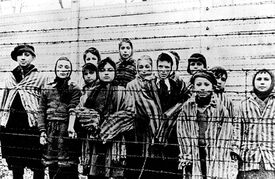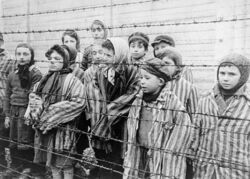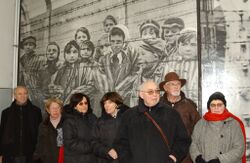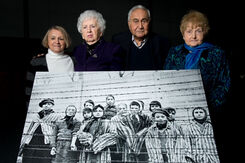Gabriel Neumann (M / Czechia, 1937-2012), Holocaust survivor
Gabriel "Gabi" Neumann (M / Czechia, 1937-2012), Holocaust survivor.
- KEYWORDS : <Auschwitz> <Czech Family Camp> <Liberation of Auschwitz> -- <Israel>
Biography
Gabi Neumann was born in Obyce, Czechoslovakia, on 25 February 1937. His parents were Jozef and Regina Neumann, and he had two siblings. In August 1944, the Sered camp in Slovakia was opened, and his family found work and a place to stay in the neighboring village of Zamianska Kert. Josef worked as a framer, and Regina was in the tobacco factory. When the Germans came, Gabi, his mother and siblings escaped to the nearby fields, while Jozef hid elsewhere. At the end of October 1944, they were betrayed, and sent back to Sered. From there they were deported to Auschwitz-Birkenau on 3 November 1944. They were informed that Jozef had been caught and sent to Auschwitz a week earlier.
For a week, the family were together in the “Family Camp” in Birkenau, but then the men and boys over age ten were separated from the women and children. Gabi was separated from his family and left by himself in the children’s block. His sister became ill, but joined him in the children’s block after her release from the camp hospital. The two children were marched from Birkenau to Auschwitz, where they stayed until the liberation.
Gabi and his sister were liberated by the Red Army on 27 January 1945. (His sister is not in the picture).
In 1949, Gabi emigrated to Israel, and eventually became a graphic artist and a teacher. A widow, and father of one, today Gabi lives in Herzliyya.
Auschwitz Picture
He is present in an iconic Auschwitz picture, that depicts 13 child survivors, shortly after the liberation of the camp. All of them have been identified. From left to right they are:
- (1) Tomy Shacham / Tomy Schwarz (M / Slovakia, 1933)
- (2) Miriam Friedman / Miriam Ziegler (F / Poland, 1933)
- (3) Pessa Balter / Paula Lebovics (F / Poland, 1933)
- (4) Ruth Muschkies / Ruth Webber (F / Poland, 1935)
- (5) Bracha Katz / Berta Weinhaber (F / Slovakia, 1930)
- (6) Erika Dohan / Erika Winter (F / Czechia, 1931)
- (7) Marta Wise / Marta Slonim (F / Slovakia, 1934)
- (8) Eva Slonim / Eva Weiss (F / Slovakia, 1931)
- (9) Gabor Hirsch (M / Poland, 1929)
- (10) Gabriel Neumann / Gabriel Nejman (M / Czechia, 1937-2012)
- (11) Shmuel Schelach / Robert Schlesinger (M / Czechia, 1934-2006)
- (12 & 13) Eva & Miriam Mozes / Eva Kor (F / Romania, 1934-2019) and Miriam Zieger (F / Romania, 1934-1993).
Gabriel Neumann was among the seven children who reunited on 27 January 2005 in the ceremony in Poland marking 60 years since the liberation of Auschwitz (photograph by Dalit Shacham). The group included (from left to right): Tomy Shacham (1); Erika Dohan (6); Marta Wise (7); Eva Slonim (8); Shmuel Schelach (11); Gabriel Neumann (10); and Bracha Katz (5).
In separate reunion four other survivors gathered in Krakow, Poland on 26 January 2015, at the invitation of the USF Shoah Foundation, on the eve of the 70th anniversary of the liberation of the death camp. The Group included (from left to right): Paula Lebovics (3), Miriam Ziegler (2), Gabor Hirsch (9), and Eva Kor (12). (Photo by Ian Gavan/Getty Images).
Yad Vashem
Born in Obyce, Czechoslovakia. In 1942, his family was deported to Novaky camp and after a short time returned to Obyce. In 1943, the family was deported to the Sered Ghetto. His mother smuggled him, his brother and sister to the fields surrounding Sered, where they were hidden for two months, until they were arrested after being informed on. They were deported back to the ghetto and then deported to Auschwitz. The family was incarcerated for a week in the Family Camp in Auschwitz-Birkenau. He and his sister were sent to the children’s block, where they remained until liberation. After the war he learned that his father was murdered on a death march from Auschwitz to Gleiwitz. In 1949, he immigrated to Israel with the Youth Aliyah. He studied graphic design at the Bezalel Academy of Art and Design.
USF Shoah Foundation
Though he is the youngest child in the photograph, Gabriel “Gabi” Neumann was not spared from the death and destruction of the Holocaust.
Gabi was born in Obyce, Czech Republic, on Feb. 25, 1937, and lived with his parents and older brother and sister. In 1944, the family was deported to the Novaky camp but was able to return to Obyce. The Sered camp opened in 1943, and Gabi’s parents found work for themselves in the nearby village Zamianska Kert, in a farm and a tobacco factory, so they and the children could avoid the camp. However, when the Germans came to take people to Sered, Gabi, his mother and siblings ran to the nearby forest and hid while his father found a different hiding place. Two months later, they were betrayed by people from the village and sent to Sered.
On Nov. 3, 1944, Gabi and his mother and siblings were sent by cattle car to Auschwitz on one of the last transports into the camp. Because the war was drawing to an end, the Nazis did not make selections for the gas chambers and sent Gabi and his family to the “family camp” section of Birkenau. After a week, Gabi, who was six years old, was left in the children’s block while his siblings and mother were sent elsewhere. Children would often disappear from their bunks for medical experiments, but Gabi believes he was saved because he slept near the back of the barrack instead of the entrance.
Except for a daily line-up and one meal a day, Gabi and the others did nothing except huddle by a small oven for warmth. His brother would sometimes visit him and pass sugar cubes through the electric fence that separated their barracks, or they would meet at the fence at night even though they could have been shot. Gabi realized that people who went to the hospital barrack could avoid the line-up, so he pretended to be sick for a time. His sister did fall ill, but joined him in the children’s block after she was released from the hospital.
In January 1945, the approaching Soviet Army triggered the Germans to send the majority of camp inmates on what would be death marches to lands that were still under German control. Gabi and the other children marched from Birkenau to Auschwitz, and made it back even after the Germans who were marching them suddenly disappeared. The Red Army liberated Auschwitz on January 27, 1945.
Gabi says that his mother found him and his sister after liberation from the names of the children in the now-famous Soviet photograph from behind the barbed wire. His father had died on a march from Auschwitz to Gleiwitz. Gabi’s brother, Elhanan Neumann, survived the war and was liberated from Mauthausen concentration camp. Elhanan lives in Israel. Gabi immigrated to Israel on a Youth Aliyah program in 1949 and later married, had one son, and became an artist and graphic designer. He died in 2012.



